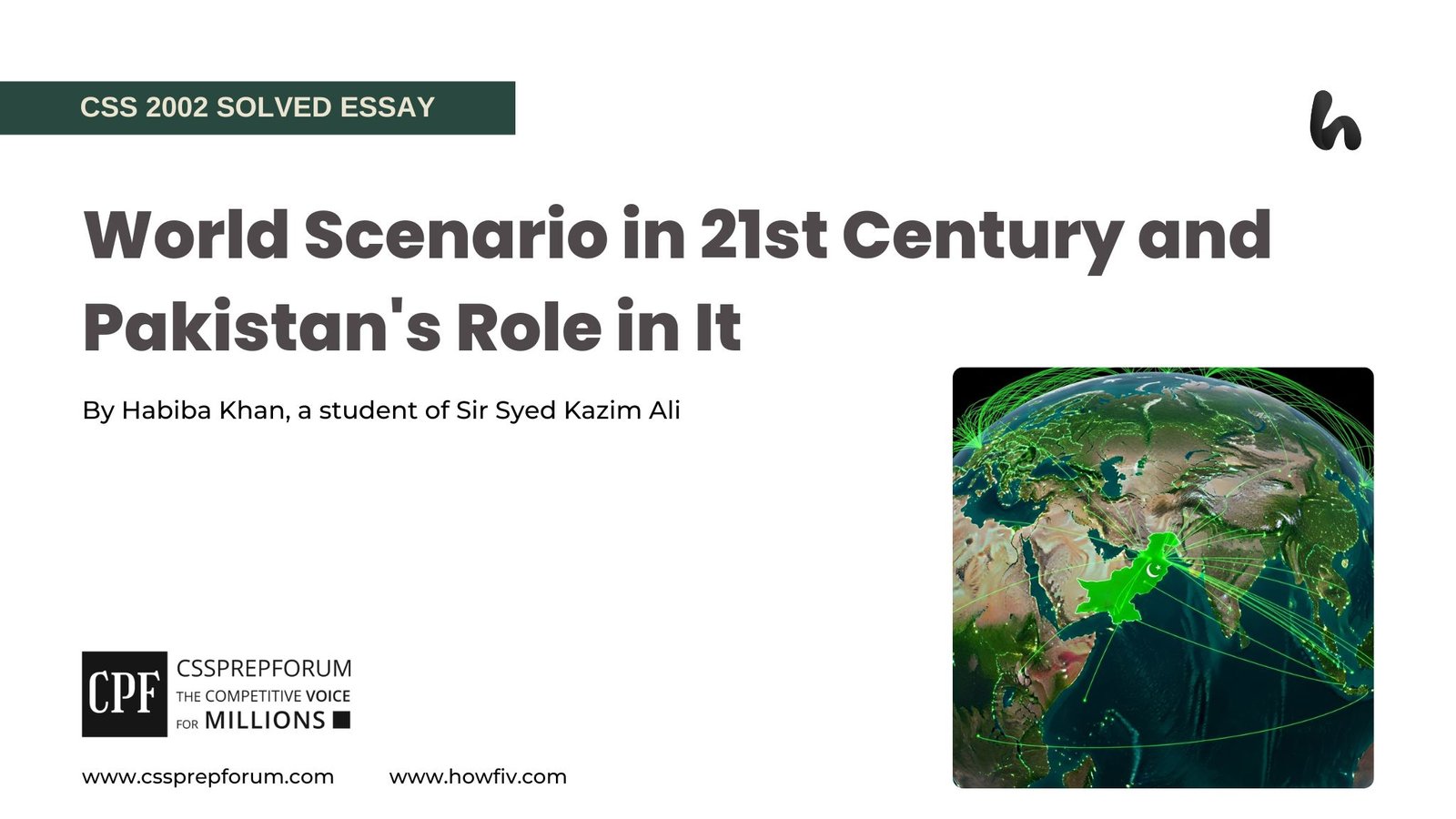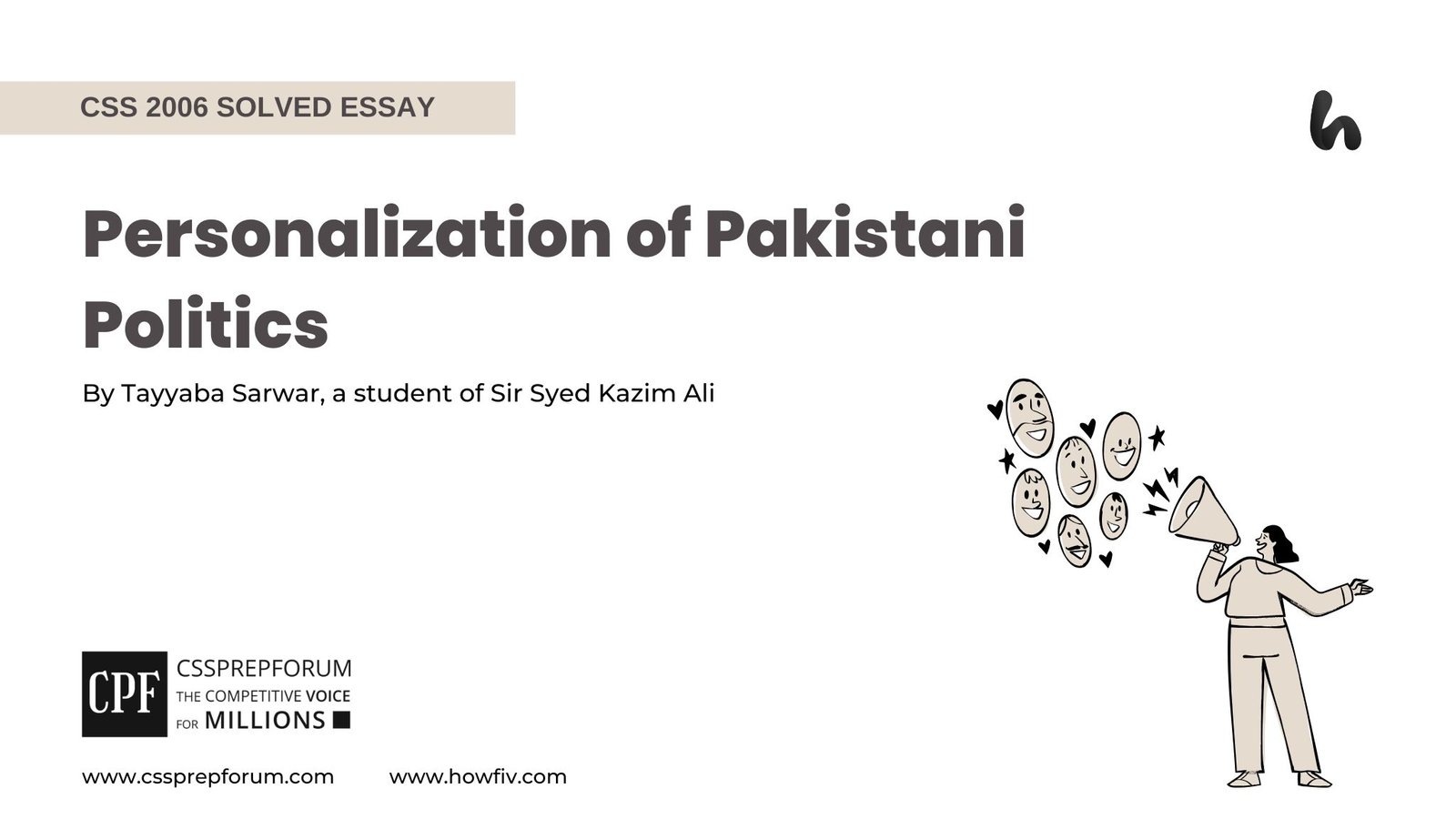CSS 2011 Solved Pakistan Affairs Past Papers | Lucknow Pact, Delhi Muslim Proposals, and the Political Developments in India
The following question of CSS Pakistan Affairs 2011 is solved by Miss Iqra Ali, the best Pakistan Affairs Coach, on the guided pattern of Sir Syed Kazim Ali, which he taught to his students, scoring the highest marks in compulsory subjects for years. This solved past paper question is uploaded to help aspirants understand how to crack a topic or question, how to write relevantly, what coherence is, and how to include and connect ideas, opinions, and suggestions to score the maximum.

Question Breakdown
In this question, the examiner has asked you three things: first, main contents; second, relative importance; and third, the impact of the Lucknow Pact and Delhi Muslim Proposals. So, start with an introduction by including all the leading points that you will add in your answer. Then, write the body of your answer by splitting it into three parts. Give equal weightage to each part. Then, end your answer with a conclusion.
Outline
1-Introduction
2-What are the Leading Contents of the Lucknow Pact and Delhi Muslim Proposals?
- ✓ Leading Contents of the Lucknow Pact (1916)
- ✓ Leading Contents of the Delhi Muslim Proposals (1927)
3-Relative Importance of the Lucknow Pact (1916)
- ✓ Breaking Divide and Uniting Against the Rule, the Unity of Two-Antagonist Communal Forces Against the British Mighty Realm
- ✓ Increased Demand for Constitutional Reforms
- ✓ Harbinger for Hindu-Muslim Communal Politics
4-Relative Importance of the Delhi Muslim Proposals (1927)
- ✓ Breaking the Ice Showed Flexibility in Muslim League’s Stance
- ✓ Indian National Congress INC’s Missed Opportunity
5-Impact of the Lucknow Pact on the Later Political Developments in the Indian Subcontinent
- ✓ A Step Forward in Accessing Rights, the Montagu-Chelmsford Reforms (1919)
- ✓ Deepened Divisions and Awakened Communal Consciousness
6-Impact of the Delhi Muslim Proposals on the Subsequent Political Developments in the Indian Subcontinent
- ✓ Prelude to Partition of the Indian Subcontinent
- ✓ Jinnah’s Ideological Shift
7-Conclusion

Answer to the Question
Introduction
The Lucknow Pact of 1916 and Delhi Muslim Proposals of 1927 symbolized a historical transition over ten years, which started with an acceptance of a distinct Minority’s long-standing demand of the separate electorates and ended with a compromise on the long-standing demand. From agreement signified consociational practice to compromise signified broader political agendas, the Lucknow Pact and Delhi Muslim Proposals impacted the succeeding political and constitutional developments in an unprecedently way. The following point describes the relative impotence and impact of both. The Lucknow Pact led to an agreement between the Indian National Congress (INC) and the All India Muslim League (AIML) of cooperation to secure the legitimate interests of the Indians. It increased the demand for constitutional reforms, facilitating the rights of the natives. Besides, the Delhi Muslim Proposals was a compromise made on behalf of AMIL to secure broad political goals. However, the INC missed the opportunity for reconciliation. Apart from this, the Pact was marked as a one-step forward in accessing rights for the locals. For illustration, the British government formalized the Montagu-Chelmsford Reforms (1919) due to the constant pressure of Indian masses for reforms. Nonetheless, the failure to build a consensus deepened the communal divisions. As far as the Proposals are concerned, their impact can be traced by analyzing the succeeding political developments. For illustration, the Hindu-centered approach of Congress set the stage for the future demand for a separate state for the Muslims of the Indian Subcontinent. To conclude, the historical transition from the Lucknow Pact of 1916 to the Delhi Muslim Proposals of 1927 demonstrated the historical turning points from nationalism against British rule to Muslim and Hindu nationalism before the British government for the attainment of liberation. However, a separate homeland in the case of the Muslims.
What are the Leading Contents of the Lucknow Pact and Delhi Muslim Proposals?
The Lucknow Pact of 1916 and Delhi Muslim Proposals of 1927, a ten-year gap (Dec 1916-Dec 1927), started with an acceptance of a distinct Minority’s long-standing demand and ended with a compromise on the long-standing demand. It was Muslim’s demand for separate electorates in the Indian Subcontinent. The following points elaborate on the leading points of the Lucknow Pact and Delhi Muslim Proposals.
- ✓ Leading Contents of the Lucknow Pact (1916)
The leading contents of the Lucknow Pact are stated below
- Through the Pact, the Indian National Congress (INC), a pan-Indian political organization and predominantly a Hindu-majority party, agreed to the All India Muslims League (AIML), a political party representing Muslim rights, demand separate electorate for the Muslims, a minority, of the Indian Subcontinent. Resultantly, Muslims would have the right to elect their representatives in Indian legislative councils.
- Then, the Pact provided for Proportional Representation for Muslims in legislative bodies. Through the Pact, the INC agreed to the point that Muslims would be elected to the Indian legislative bodies in proportion to their population in the respective regions.
- Also, through the Pact, the parties, namely INC and AIML, demanded greater autonomy for provinces to strengthen self-rule through representation in the provinces.
- Through the Pact, the Hindu and Muslim communities demanded an increase in the number of Indians in legislative councils. Also, they demanded greater autonomy and influence over the budget and lawmaking.
- ✓ Leading Contents of the Delhi Muslim Proposals (1927)
The leading contents of the Delhi Proposals are stated below
- The AIML, a political party representing Muslim rights, proposed a compromise on the demand of separate electorates for the Muslim community in a condition. The condition was to ensure and safeguard Muslim representation in the decision-making.
- Then, AIML proposed for one-third participation in central and provincial legislatures,
- Also, AIML proposed more autonomy for Muslim-majority provinces, namely Bengal, Punjab, and North West Frontier Province NEFP. However, the party proposed for non-interference of the central government on matters related to these provinces.
- The party proposed for an assurance from the government regarding the protection of the religious-cultural and educational rights of the Muslim community.
Relative Importance of the Lucknow Pact (1916)
The following points describe the relative importance of the Lucknow Pact of 1916 between the Indian National Congress (1885) and the All-India Muslim League (1906).
- ✓ Breaking Divide and Uniting Against the Rule, the Unity of Two-Antagonist Communal Forces Against British Mighty Realm
First, after years of antagonism towards each other, the Lucknow Pact was the first consociational practice between the two leading parties. Considering the constant demand for self-rule in the Indian Subcontinent, the Lucknow Pact symbolized a joint effort countering foreign rule. However, it was also a joint adventure of the parties to gain concessions from the British government.
- ✓ Increased Demand for Constitutional Reforms
Second, the Lucknow Pact led to an increase in demand for constitutional reforms for more autonomy and representation in the Indian legislative and Executive Councils. In addition, it strengthened the demand for self-rule in the Indian subcontinent. For illustration, the demand for constitutional reforms increased the pressure of the Indian masses on the British government.
- ✓ Harbinger for Hindu-Muslim Communal Politics
Last, the Pact institutionalized communal politics, setting the stage for communal divisions in the future. The Hindus and Muslims realized that communal issues could not be dealt with by power sharing. The Congress’s designs proved that Muslims and Hindus could not survive under Hindu-denominated democratic rule. Thus, it can be said that the Lucknow Pact was a harbinger for Hindu-Muslim communal politics.
Relative Importance of the Delhi Muslim Proposals (1927)
The following points describe the relative importance of the Delhi Muslim Proposals of 1927.
- ✓ Breaking the Ice Showed Flexibility in Muslim League’s Stance
First, the Delhi Muslim Proposals was an attempt by the League to cooperate with the Congress. The Muslim league compromised on the years of constant demand for separate electorates. Nonetheless, it was meant to secure broader political goals. The flexibility in the League’s stance provided the way for a realization that Muslims would be rejected in the decision-making process in a Hindu-dominated rule. For illustration, the Nehru Report of 1928 and subsequent political developments proved that Congress had the always ready option of neglecting Muslim demands despite representing it before the government as a pan-Indian political organization.
- ✓ Indian National Congress INC’s Missed Opportunity
Nevertheless, the Congress missed the opportunity that might have opened the doors of reconciliation between the Muslims and the Hindus. The Congress’s Hindus-centered approach while sidelining Muslim interests paved the way for future political instability. However, it also added fuel to the fire of communal clashes that led to extreme social segregation.
Impact of the Lucknow Pact on the Later Political Developments in the Indian Subcontinent
Coming to the point of the impact of the Lucknow Pact on the later political developments in the Indian Subcontinent, the following points demonstrate the analysis.
- ✓ A Step Forward in Accessing Rights, the Montagu-Chelmsford Reforms (1919)
By keeping in consideration the future constitutional developments, the impact of Lucknow can be traced, such as the Montague Chelmsford reforms of 1919. As a result of the growing pressure from the two communities, the British government considered the proposals and formalized the Indian Constitutional Act of 1919. For example, the Reforms led to an increase in the franchise and majority of elected members and extended authority to central and provincial legislative councils. Also, the Act provided for an increase in the number of Indians in the Viceroy’s Executive Council, which would be three out of eight members.
- ✓ Deepened Divisions and Awakened Communal Consciousness
Then, the later social and political developments demonstrated that the Pact deepened the divisions and awakened communal consciousness. For example, Congress agreed to the demand of the separate electorate’s awakened communal consciousness. The failure to make a consociational practice in politics showed the Muslims that their interests could not be legitimized under the Congress rule.
Impact of the Delhi Muslims Proposals on the Subsequent Political Developments in the Indian Subcontinent
The following points describe the impacts of the Delhi Muslim Proposals on the subsequent political developments in the Indian Subcontinent.
- ✓ Prelude to Partition of the Indian Subcontinent
First, Congress’s failure to build a consensus led to political polarization in British India. The Muslims and Hindus separately worked for their interests, and joint efforts lagged behind. The Congress designs deepened mistrust between the two communities. Later, the party maintained its Hindu-centered approach, facilitating Hindus only. Notably, it set the stage for the future demand of a separate state by the Muslims.
- ✓ Jinnah’s Ideological Shift
Indubitably, the undisputed leadership of Jinnah maintained the fact that Jinnah’s political approach influenced the party’s direction. The failure of the Delhi Muslims Proposals shifted Jinnah’s nationalist ideology to pro-communalism. He realized that Muslims and Hindus would never agree on the same point, especially power sharing. The ideological shift of Jinnah began the constitutional struggle for a separate nation for the Muslims of the Indian Subcontinent.
Conclusion
To conclude, the Lucknow Pact of 1916 and the Delhi Muslim Proposals of 1927 reflected two phases of Hindu-Muslim relations in the colonial Indian Subcontinent. The transition from promoting unity to deepened divisions impacted the later political developments. The failure to build a consensus led to social stratification. The Muslims and Hindus and their leaders were at daggers drawn with each other. Besides, the failure to build a consensus deepened mistrust and Muslims realized that their interest could not be secured under the Hindu-dominated India.
CSS 2011 Solved Pakistan Affairs
| 2-Briefly Analyse and Discuss the Contribution of the Religious Reformers – Sheikh Ahmad Sirhindi, Shah Waliullah, Syed Ahmad Barelvi and the Like – in the Growth of Muslim Consciousness in the South-Asian Subcontinent. | |
| 3-John Plamenatz Defines ‘Nationalism’ as “The Desire to Preserve or Enhance Peoples National or Cultural Identity, When that Identity is Threatened or the Desire to Transform or Even Create it When it is Felt to be Inadequate or Lacking.” In the Light of above Definition, Briefly but Comprehensively Discuss the Respective Roles Played by Sir Syed Ahmad Khan, Allama Iqbal and the Quaid-E-Azam in Strengthening the Muslim Nationalism in India. | |
| 4-Describe the Main Contents and Relative Importance of the Lucknow Pact and Delhi Muslim Proposals and their Respective Impact on the Subsequent Political Developments in India. | |
| 5-Can the Lahore Resolution be termed as the ‘Magna Carta’ of Pakistan? Take a position and support your argument by historical facts, if any. | |
| 6-Give a Critical Appraisal of the Constitutional Crisis/Crises Initiated by the Controversial Actions taken by Governor General Ghulam Muhammad and Endorsed by the Superior Court of Pakistan. Discuss and Analyse its Effects on the Subsequent History of Pakistan. | |
| 7-Federalism Has Been a Continuing Cause of Political Tension in our Country. Will the 18th Amendment Made in the Constitution by the Present Government Solve this Issue Once for All? Take a Position and Support With Your Argument. | |
| 8-Given the Problems that Pakistan is Facing Today, What is Your Vision of Pakistan in the Year 2011? How, in Your Opinion, can be its Internal and External Problems solved? |
CSS Solved Past Papers’ Essays
Looking for the last ten years of CSS and PMS Solved Essays and want to know how Sir Kazim’s students write and score the highest marks in the essays’ papers? Then, click on the CSS Solved Essays to start reading them.
CSS Solved Essays
CSS Solved General Science & Ability Past Papers
Want to read the last ten years’ General Science & Ability Solved Past Papers to learn how to attempt them and to score high? Let’s click on the link below to read them all freely. All past papers have been solved by Pakistan’s top CSS GSA coach having the highest score of their students.
General Science & Ability Solved Past Papers












